
Founded by seasoned scrambler Mike Graham, a figurehead of the free-spirited Yosemite rock climbing scene, the Gramicci story began in 1982. During his time scaling massive cliffs in the ’70s, Mike and a group of fellow climbers ascended Yosemite’s Half Dome, a 2,694 m granite dome in California famed for its unique shape. To conquer this feat, the team daftly adopted Italian pseudonyms, making it the first “all-Italian ascent”. Graham became Gramicci, and needless to say, the name stuck. Unable to find shorts suited to his climbing requirements, Graham set about making his own. Incorporating a host of industry innovations, such as an engineered gusseted crotch for unrestrictive movement and an integrated nylon belt, the introduction of Graham’s first pair of shorts in 1982 under his Gramicci moniker would change the outdoor clothing industry forever and pave the way for the Gramicci brand.
1988 saw the release of the G Pant, an evolution of the short constructed from hard-wearing organic cotton twill that quickly became a must-have among the climbing community. Fast forward to 2021, nearly four decades after its inception, Gramicci continues to push the boundaries of sustainable, user-friendly design. Always staying true to their roots, Gramicci continue to play an important role in altering widespread perceptions of utilitarian clothing.
No doubt aided by the Gorpcore boom, Gramicci is going from strength to strength – it’s well and truly here to stay, now more than ever. We had a chat with Gramicci’s current global creative director Stephan Wendler to dig a little deeper into his background and find out how he’s dealt with the past year.

So Stephan, how’s it going? How is life treating you in this strange world we’re living in?
It’s going well. Fortunate to be in Japan during these turbulent times.
You’ve got some pretty impressive work experience, tell me where it all began, what sparked your interest in clothing?
I guess if I look way back, my interest in clothing really began playing in bands, going to shows and skateboarding. I was always interested in how people dressed, what DIY hXc-punk patches and local band tee’s people wore, stuff like that. And obviously skateboarding in the 90s had a huge impact in terms of brands. Throughout high school I began working at a local screen printer, mostly at weekends or for a few hours after school – that probably sparked my interest in the creation side of things. It was never my ambition, nor did I ever think I would end up working in this industry, I actually ended up studying business.
From the looks of things, you’ve done some serious globetrotting in your time. Where are you from originally? What’s the best place you’ve lived so far?
I’m originally from Berlin, but have moved around a lot ever since my early childhood days. I grew up in Europe, spent my teenage years in Chicago and as I moved into the job world I have worked at different companies in different cities throughout Europe and the US. I recently relocated from LA to Japan and I think this may become one of my favorite places to live so far. It’s definitely been my favourite travel destination over the past decade.
You’re currently the global creative director at Gramicci. What led you to this role, where have you worked along the way?
I actually don’t come from the classic outdoor industry as such. I worked in product at Stussy, Carhartt WIP and Nike in my early days. The conversation with Gramicci Japan started after working on a collaboration project with them during my time at Stussy. We created this hybrid cargo zip-off pant, based on one of Gramicci’s early classic climbing fits. I’ve personally always enjoyed their product and picked up their shorts and pants during my many trips out to Tokyo. Though Gramicci has always been very present in retail, there was this overall mysterious aspect to the brand. Looking at other companies within our industry, usually you would know some people working here and there, or at least know where their office is based. In Gramicci’s case, it really felt like no one knew anything about them and that was pretty intriguing for a 40-year-old brand to have.

What have you learnt from your previous roles? Has your past experience shaped the way you approach things at Gramicci?
Definitely! I have been very fortunate to have worked with really great brands and extremely talented teams throughout my past – from whom I have probably learned almost everything from! I think I approach things differently than someone who may have come from the classic outdoor route. I’m definitely looking at different inspiration, references and partnerships that all flow into the Gamicci collection. And then there’s also the whole other cultural side of things.
Our industry is currently experiencing a fast shift towards becoming DTC led brands, with the US taking the lead and paving the way. Having worked in that fast-paced environment, it really changes everything from designing, implementing express-lane developments and essentially how to plan, launch and interact with fans on an ongoing weekly basis. In Japan, the cultural landscape is still very wholesale driven, and this is easily noticeable, just look at how brands’ Instagram accounts are rolled out here. On the upside, the Japanese wholesale doors, and their attention to detail, continue to be the best in the world and it forces you to see things through a different lens at times.
Over the past few years outdoor clothing has become intertwined with streetwear and high-end fashion – whether it’s under the guise of a high-profile collaboration or taking design cues from classic outdoor staples (it seems like every brand going has its own variation of a climbing pant these days). Why do you think it’s become so popular? Do you think the functional nature of outdoor gear adds to its appeal?
While 2020 may certainly been the peak, the worlds of outdoor gear and streetwear have been colliding well into the early 90s. Just think of The North Face’s classic Nuptse, which has been a streetwear staple seen on the kids and skateboarders of New York, and in the pages of early Asayan magazine issues. It’s been a timeless capsule of Americana that sits alongside early US workwear staples and sportswear. Then if you fast forward to the late 00s, that’s when in my opinion the most notable brand X brand projects came into play – followed by Junya Watanabe and TNF’s link, Arc’teryx’s first retail collaboration projects, numerous early Japanese exclusive retail SMUs which were mostly just colour variations; eventually followed by Nike’s revival of their late 80’s ACG line and of course Paris’ pioneering Broken Arm Salomon release.
One may argue that Covid-19 and its lockdown measures has accelerated outdoor gear becoming one of the most recent defining trends in apparel. As most indoor socializing activities as we know it were banned, hiking and walking became the daily socially distant solution. The REI’s and Oshman’s around the globe quickly became the new go-to’s – because let’s face it, if you’re going to explore, you’re simply going to want the right gear. On top of this, the whole outdoor aesthetic of colour, fabric, functionality and comfort just simply looks good – so it’s of no surprise that streetwear and high-end fashion brands continue to tap into it.

“I find that our coolest pieces are actually our 90s catalogs and advertisements, where you really see that tongue-in-cheek Gramicci vibe come to life. “
The term “Gorpcore” is thrown around a lot these days. I’m just as likely to see someone in a pair of Salomons and a Gore-Tex jacket in Co-op as I am hiking in the peak district. The question is, how big can it get? What do you think the lasting impact will be for a brand like Gramicci?
It’s definitely here to stay. We’re glad to see people are actively enjoying the outdoors and making overall increasingly smart purchasing decisions when it comes to quality, durability and sustainability. This all has a tremendous positive impact.
It’s been a difficult year to stay motivated. What do you do/where do you look for creative inspiration in a time like this?
When it comes to vintage digging, there isn’t a better place than Japan. As we all know, their love, obsession and expertise for anything collectible is mind blowing. I mean it’s literally all been here for decades. From your 90s GAP, vintage Oakley apparel, to Mont-bell, L.L. Bean and all of the US deadstock outdoor/sportswear gear. It’s overwhelming, but you begin to find out where to go for specific things. It all seems very categorised, even when digging through rag-houses in the outskirts of the city. And then there’s the specialised stores like Epoch out in Kobe, who bring outdoor deadstock to an entirely different level. But for most us, there are so many immense online platforms like Organiclab, Mercari, and even the likes of Etsy to find inspiration. On top of this, we’re fortunate to have an extensive 40-year-old Gramicci archive to look back at. We have our iconic styles and fabrics from every notable era and some crazy footwear designs from past licensees. I find that our coolest pieces are actually our 90s catalogs and advertisements, where you really see that tongue-in-cheek Gramicci vibe come to life.
I’m a strong believer of a healthy work/life balance, whether that’s always realistic is another story. What do you enjoy doing outside of work?
Right now, it’s really just exploring the city and everything that comes with it. Once you think you have seen most spots and stores of a district, it just continues to spread into the different levels of multi-story buildings. The higher you go, the crazier the stores. So yeah, I mostly spend my weekends exploring by foot and bike, which is something I really missed when living in LA.
You’re living in Japan at the minute aren’t you, it’s a place that has been at the top of my travel list for a while now. Is it as good as it looks?
You should definitely go as soon as we can all travel again. And if you have enough time, I highly recommend checking out other prefectures and cities besides Tokyo. Hayama-machi and Kyoto are some of my favourites.
If your life were a film, what songs would be on the soundtrack?
The American Football band and our multidisciplinary designer Satoshi Yamane’s band Toe – who by the way, also heads up the brand F/CE.
Tell us about the new Gramicci SS21 collection. What are the key influences?
Like I touched on earlier, we’re lucky to have an awesome 40-year-old Gramicci archive to dig into, that’s kind of our biggest influence. The collections have always deeply resembled a specific era – so it’s exciting to pick up certain fits and fabrics, flip them where necessary and find a nice place for them. Of course, we’re mainly inspired by the outdoors, certain functionalities that feel right for Gramicci and the garment’s purpose. We have a huge global fan base, so we try to cater best to all of their needs – whether that’s for climbing, hiking, or simply enjoying the urban landscape.
It’s full of colour and eye-catching patterns, are there any pieces, in particular, to look out for?
Definitely our family of twill classics in a large array of garment dyes and fits. My personal favourites are the packable shorts in a durable shell, they’re literally perfect for anything you do. We have some really nice colours, wild mashups, tie-dyes and a couple of all-over prints. It’s been something that Gramicci had done since day one – it really goes back to that fun tongue-in-cheek outdoor Gramicci vibe.
And finally, is there a better fitting pair of trousers than the original G pant?
Haha nothing beats the original Gramicci pant – it’s such a great and timeless design.
All pictures courtesy of Stephan Wendler.

